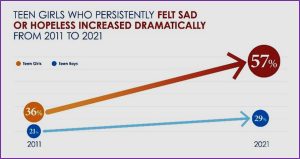
More Teenage Girls Are Feeling Hopeless And Sad – CDC Report
Recently CDC reported that teenage girls in United states are experiencing higher levels of sadness, acts of violence. The report published earlier this month with analysis and survey by Youth Risk Behavior Survey reveals that nearly 3 in 5 girls persistently feel sad or hopeless and this is up from 36 % (in year 2011)and has reached highest level to 57%. According to Dr. Debra Houry CDC’s CM officer America’s teen girls are engulfed in a growing wave of sadness, violence and trauma. One of the reason for this is, these girls are experiencing an increase in mental health issues, violence, sexual abuse and with this there is also an increase of suicide risk.
Is this report holds good only for US or to the world? Girls are more vulnerable and are subject to abuses in various ways in different part of the world. No doubt girls are getting more educated, meanwhile the violence and sexual abuse has been increasing with girls. Why there is an increase in sadness and hopelessness in teenage girls? In interviews with teenage girls, many girls revealed that they had been forced to have sex, there is sexual violence and LGBQ students are facing mental health challenges due to violence. A constant exposure to such environment is driving teenage girls towards suicidal thoughts. LGBTQ students and students who have same sex partners were more likely to seriously consider suicide attempt at 45% to 58% respectively – as per the report. It is important for other countries also (if not already) to take this matter seriously in their respective countries to stop violence and abuse that makes children hopeless and sad – Healthy Life
Read full report from CDC below:
While all teens reported increasing mental health challenges, experiences of violence, and suicidal thoughts and behaviors, girls fared worse than boys across nearly all measures. The new report also confirms ongoing and extreme distress among teens who identify as lesbian, gay, bisexual, or questioning (LGBQ+).
“High school should be a time for trailblazing, not trauma. These data show our kids need far more support to cope, hope, and thrive,” Debra Houry, M.D., M.P.H., CDC’s Chief Medical Officer and Deputy Director for Program and Science. “Proven school prevention programs can offer teens a vital lifeline in these growing waves of trauma.”
The analysis includes 2021 data and trends from the Youth Risk Behavior Survey (YRBS), which examines health behaviors and experiences among U.S. high school students. Youth mental health has continued to worsen—with particularly stark increases in widespread reports of harmful experiences among teen girls:
- Nearly 1 in 3 (30%) seriously considered attempting suicide—up nearly 60% from a decade ago.
- 1 in 5 (18%) experienced sexual violence in the past year—up 20% since 2017, when CDC started monitoring this measure.
- More than 1 in 10 (14%) had ever been forced to have sex—up 27% since 2019 and the first increase since CDC began monitoring this measure.

The report also found more than half (52%) of LGBQ+ students had recently experienced poor mental health and, concerningly, that more than 1 in 5 (22%) attempted suicide in the past year. Trend data are not available for students who identify as LGBQ+ due to changes in survey methods.
Findings by race and ethnicity also show high and worsening levels of persistent sadness or hopelessness across all racial and ethnic groups; and that reported suicide attempts increased among Black youth and White youth.
“Young people are experiencing a level of distress that calls on us to act with urgency and compassion,” said CDC Division of Adolescent and School Health Director Kathleen Ethier, Ph.D. “With the right programs and services in place, schools have the unique ability to help our youth flourish.”
School-based activities can make a profound difference in the lives of teens with a relatively small infusion of support to schools. More than 95% of U.S. youth spend much of their daily lives in school. While their primary goal is academic learning, schools can take evidence-based steps to foster the knowledge, skills and support needed to help prevent and reduce the negative impact of violence and other trauma and improve mental health. For example, safe and trusted adults—like mentors, trained teachers, and staff—can help foster school connectedness, so that teens know the people around them care about them, their well-being, and their success. Schools can provide education that equips teens with essential skills, such as understanding and ensuring true sexual consent, managing emotions, and asking for what they need. Schools can also connect teens to their classmates and communities through school-based clubs and community outreach.
CDC has collected and analyzed data on youth health and well-being for more than three decades. These data are a critical first step to revealing, understanding, and addressing emerging threats to the health and well-being of the nation’s youth.
Image credit: Image by Enrique Meseguer from Pixabay (CC by 0)
Author: Sumana Rao | Posted on: February 27, 2023
« Waist size is more important for your heart health Mysterious Flu -Adenovirus Threat in West Bengal »






















Write a comment